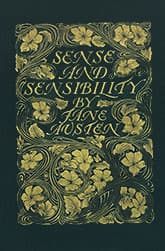Sense and Sensibility
Critique • Quotes • At the movies
 1899 edition
1899 editionFirst publication
1811
Literature form
Novel
Genres
Literary, romance
Writing language
English
Author's country
England
Length
Approx. 119,500 words
Full-blown birth of the Austen novel
In the dichotomy suggested in the title, Jane Austen in her first published work comes down conclusively on the side of sense over sensibility.
It's supposed to be a study of two marriageable sisters with the eldest, Elinor, presenting her case for calm common sense in relationships, while the other, Marianne, flaunts her flamboyantly romantic nature. (A third, much younger sister, does not rate titular representation.)
It's clear Austen prefers the older sister's approach. Much of the narrative of Sense and Sensibility follows events as seen from Elinor's perspective and relates Elinor's often anguished thoughts beneath her placid exterior, despite Marianne providing most of the emotional sturm und drang of the novel.
Literary historians have pointed out Austen's novel was first drafted as a response to the prevailing sentimentality and subjective expression of feeling in literature of the late 1700s—especially in the writing of popular lady novelists.
Opposing the sentimentalists
By the time Austen's novel was being reworked for publication in the early 1800s, excessive sentimentalism had almost run its course and was being replaced by the related school of romanticism that came to dominate the century. Think William Wordsworth, Walter Scott, Alexander Pushkin, the Brontës, Victor Hugo, Alexandre Dumas.
But don't include Austen in this circle either, for however she satirized the constricted circles of her day she always did it from the position of a conservative respecter of social norms. In Sense and Sensibility, as it evolved into what appeared in 1811, she takes on the combined sentimentalist and romantic tendencies, as represented most acutely in the characters of Marianne and her dashing suitor, Willoughby.
When Willoughby enters the story on horseback and sweeps Marianne off her feet, that's romanticism. When Willoughby pretentiously rhapsodizes over the uncomfortable cottage the Dashwood women live in, warning that improving even an inch of it would bruise his feelings, that's sentimentalism at its silliest.
Marianne's pathetic suffering from losing Willoughby's affection and drawing the sympathy of all about her, that too is the romantic temperament at work. It contrasts sharply with the emotional turmoil of Elinor who keeps her own wounded heart hidden, the better to serve others.
Austen's novels all pose moral and social contrasts of various kinds, but this first theme of rationality versus romanticism (sense versus sensibility) is also worked out in almost all her writing. The choice however is never as clear-cut as in this first novel. Later, you can find Austen expressing the contradiction with more nuance and you may detect a questioning of her earlier certainties. But it's always there.
The marriage plot
In this way and a dozen ways, Sense and Sensibility lays out a blueprint of sorts for all her works. Despite being one of Austen's slightest, most superficial novels, it is a perfect introduction to her work—for it introduces within its highly readable pages all the elements found in her later, heavier novels.
There's the standard marriage plot of course—the families with multiple daughters in need of wealthy husbands. There's the complex plotting of characters both competing and cooperating to find their proper matches. Conflicting views are played out on whether love and understanding are necessary in beneficial relationships. Appearances are shown to be deceptive, with at least one seemingly perfect suitor turning out to be a complete scoundrel and one seemingly unsuitable eligible male turning out to be an ideal catch. Monumental misjudgments afflict the chances of the central female characters, but all misunderstandings are resolved in the end.
Speaking of which, Sense and Sensibility has one of the more affecting climaxes, as Elinor's misconceptions are cleared up in a clever plot twist and she unexpectedly finds belated happiness.
The euphoria is diluted somewhat though by a hurried exposition in the final chapter, tying up loose ends rather matter-of-factly—including Marianne's final capitulation by marrying the dull but honourable Brandon.
This echoes a fault in some of the earlier narrative: as great a story as it is, Austen's writing powers have yet to peak, and to hold the strands of her complex plots together she occasionally resorts to telling rather than showing.
Still, Sense and Sensibility must have seemed very fresh to its readers back then. It still entertains today, more than the sentimental, overly decorated material that preceded it and is today forgotten.
It shows Austen having worked out how to write from her limited experience to appeal to a wide range of people. The stripped down description, the third-person voice that nonetheless presents the inner thoughts of characters, the subtle satire, the conversations that drive her stories, dialogue that reveals the opposite of what speakers intend—these features are all Austen specialties, some are her inventions, and they appear full-blown in her first published, if not first written,novel.
It's not her very best work. It's somewhat lighter-weight than the two or three masterpieces to come. But still Austen's Sense and Sensibility is an engaging read compared to the novels of other writers of her time we no longer care about.
— Eric
Critique • Quotes • At the movies

